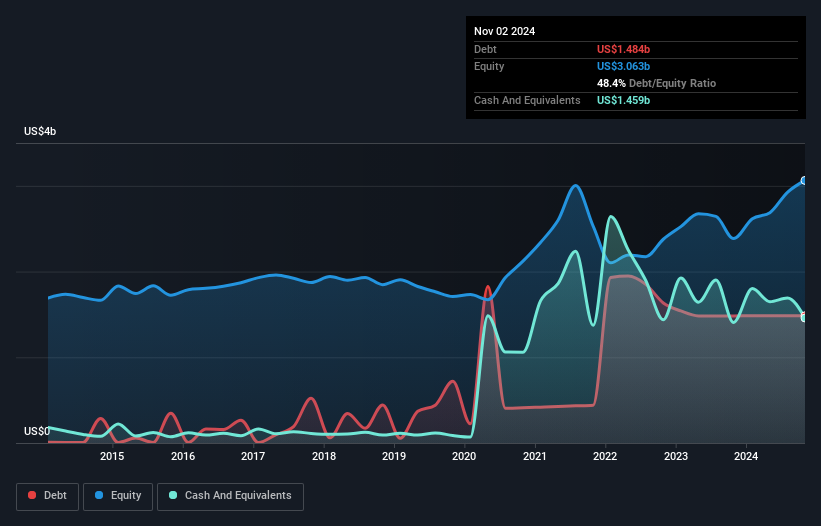- United States
- /
- Specialty Stores
- /
- NYSE:DKS
DICK'S Sporting Goods (NYSE:DKS) Has A Pretty Healthy Balance Sheet

Howard Marks put it nicely when he said that, rather than worrying about share price volatility, 'The possibility of permanent loss is the risk I worry about... and every practical investor I know worries about.' So it seems the smart money knows that debt - which is usually involved in bankruptcies - is a very important factor, when you assess how risky a company is. We can see that DICK'S Sporting Goods, Inc. (NYSE:DKS) does use debt in its business. But the more important question is: how much risk is that debt creating?
When Is Debt Dangerous?
Debt is a tool to help businesses grow, but if a business is incapable of paying off its lenders, then it exists at their mercy. In the worst case scenario, a company can go bankrupt if it cannot pay its creditors. However, a more frequent (but still costly) occurrence is where a company must issue shares at bargain-basement prices, permanently diluting shareholders, just to shore up its balance sheet. Of course, the upside of debt is that it often represents cheap capital, especially when it replaces dilution in a company with the ability to reinvest at high rates of return. The first thing to do when considering how much debt a business uses is to look at its cash and debt together.
Check out our latest analysis for DICK'S Sporting Goods
What Is DICK'S Sporting Goods's Debt?
The chart below, which you can click on for greater detail, shows that DICK'S Sporting Goods had US$1.48b in debt in November 2024; about the same as the year before. On the flip side, it has US$1.46b in cash leading to net debt of about US$25.3m.

How Healthy Is DICK'S Sporting Goods' Balance Sheet?
Zooming in on the latest balance sheet data, we can see that DICK'S Sporting Goods had liabilities of US$3.22b due within 12 months and liabilities of US$4.17b due beyond that. On the other hand, it had cash of US$1.46b and US$225.7m worth of receivables due within a year. So its liabilities total US$5.70b more than the combination of its cash and short-term receivables.
While this might seem like a lot, it is not so bad since DICK'S Sporting Goods has a huge market capitalization of US$18.6b, and so it could probably strengthen its balance sheet by raising capital if it needed to. However, it is still worthwhile taking a close look at its ability to pay off debt. But either way, DICK'S Sporting Goods has virtually no net debt, so it's fair to say it does not have a heavy debt load!
We measure a company's debt load relative to its earnings power by looking at its net debt divided by its earnings before interest, tax, depreciation, and amortization (EBITDA) and by calculating how easily its earnings before interest and tax (EBIT) cover its interest expense (interest cover). The advantage of this approach is that we take into account both the absolute quantum of debt (with net debt to EBITDA) and the actual interest expenses associated with that debt (with its interest cover ratio).
With debt at a measly 0.014 times EBITDA and EBIT covering interest a whopping 27.4 times, it's clear that DICK'S Sporting Goods is not a desperate borrower. Indeed relative to its earnings its debt load seems light as a feather. And we also note warmly that DICK'S Sporting Goods grew its EBIT by 14% last year, making its debt load easier to handle. When analysing debt levels, the balance sheet is the obvious place to start. But ultimately the future profitability of the business will decide if DICK'S Sporting Goods can strengthen its balance sheet over time. So if you're focused on the future you can check out this free report showing analyst profit forecasts.
Finally, a company can only pay off debt with cold hard cash, not accounting profits. So the logical step is to look at the proportion of that EBIT that is matched by actual free cash flow. In the last three years, DICK'S Sporting Goods's free cash flow amounted to 49% of its EBIT, less than we'd expect. That's not great, when it comes to paying down debt.
Our View
DICK'S Sporting Goods's interest cover suggests it can handle its debt as easily as Cristiano Ronaldo could score a goal against an under 14's goalkeeper. And the good news does not stop there, as its net debt to EBITDA also supports that impression! When we consider the range of factors above, it looks like DICK'S Sporting Goods is pretty sensible with its use of debt. That means they are taking on a bit more risk, in the hope of boosting shareholder returns. The balance sheet is clearly the area to focus on when you are analysing debt. However, not all investment risk resides within the balance sheet - far from it. To that end, you should be aware of the 1 warning sign we've spotted with DICK'S Sporting Goods .
If, after all that, you're more interested in a fast growing company with a rock-solid balance sheet, then check out our list of net cash growth stocks without delay.
New: Manage All Your Stock Portfolios in One Place
We've created the ultimate portfolio companion for stock investors, and it's free.
• Connect an unlimited number of Portfolios and see your total in one currency
• Be alerted to new Warning Signs or Risks via email or mobile
• Track the Fair Value of your stocks
Have feedback on this article? Concerned about the content? Get in touch with us directly. Alternatively, email editorial-team (at) simplywallst.com.
This article by Simply Wall St is general in nature. We provide commentary based on historical data and analyst forecasts only using an unbiased methodology and our articles are not intended to be financial advice. It does not constitute a recommendation to buy or sell any stock, and does not take account of your objectives, or your financial situation. We aim to bring you long-term focused analysis driven by fundamental data. Note that our analysis may not factor in the latest price-sensitive company announcements or qualitative material. Simply Wall St has no position in any stocks mentioned.
About NYSE:DKS
DICK'S Sporting Goods
Operates as an omni-channel sporting goods retailer primarily in the United States.
Undervalued with solid track record and pays a dividend.
Similar Companies
Market Insights
Community Narratives




